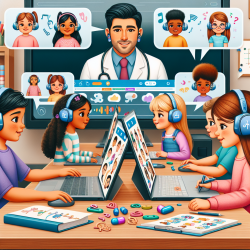The recent study titled "Feasibility of a Supplemental Phonological Awareness Intervention via Telepractice for Children with Hearing Loss: A Preliminary Study" presents valuable insights for speech-language pathologists (SLPs) looking to improve their service delivery models. Conducted by Lee, Hall, and Sancibrian (2017), this research examines the effectiveness of telepractice compared to traditional in-person interventions for enhancing phonological awareness in children with hearing loss.
Study Overview
The study involved 20 children with hearing loss, divided into two groups: one receiving telepractice intervention and the other receiving in-person services. Both groups underwent a 12-week supplemental phonological awareness intervention, targeting skills such as rhyme identification, phoneme identity, syllable-phoneme changes, and speech-to-print concepts. The study found no significant differences in outcomes between the two groups, suggesting that telepractice is as effective as in-person intervention for improving phonological awareness skills.
Key Findings
- Both telepractice and in-person interventions led to significant improvements in phonological awareness skills.
- No significant differences were observed between the two groups' performance post-intervention.
- The study suggests that telepractice is a feasible and effective service delivery model for children with hearing loss.
Implications for Practitioners
For SLPs, these findings underscore the potential of telepractice as a viable alternative to in-person services, particularly in areas with limited access to qualified professionals. Here are some actionable steps practitioners can take:
- Adopt Telepractice: Given its demonstrated effectiveness, SLPs should consider integrating telepractice into their service delivery models, especially for remote or underserved populations.
- Customize Interventions: Tailor phonological awareness interventions to meet the individual needs of children, whether delivered via telepractice or in-person.
- Monitor Progress: Use standardized assessments to track improvements in phonological awareness skills, ensuring that interventions are effective.
Encouragement for Further Research
While this study provides compelling evidence for the feasibility of telepractice, further research is needed to explore its long-term effects and applicability across different age groups and degrees of hearing loss. Practitioners are encouraged to contribute to this growing body of research by conducting their own studies and sharing findings with the wider community.
To read the original research paper, please follow this link: Feasibility of a Supplemental Phonological Awareness Intervention via Telepractice for Children with Hearing Loss: A Preliminary Study.










